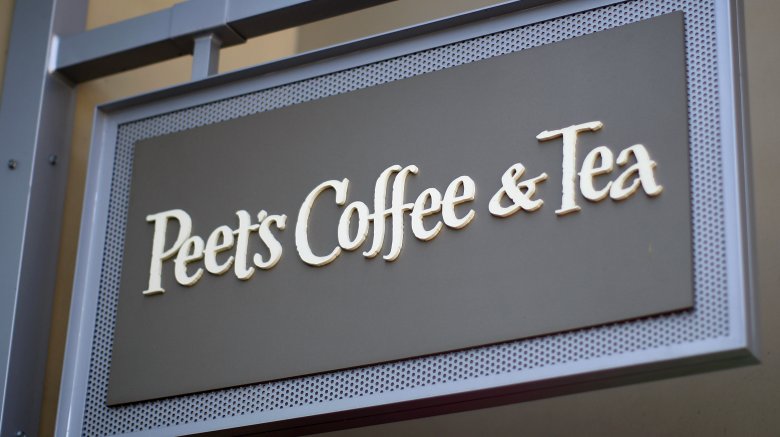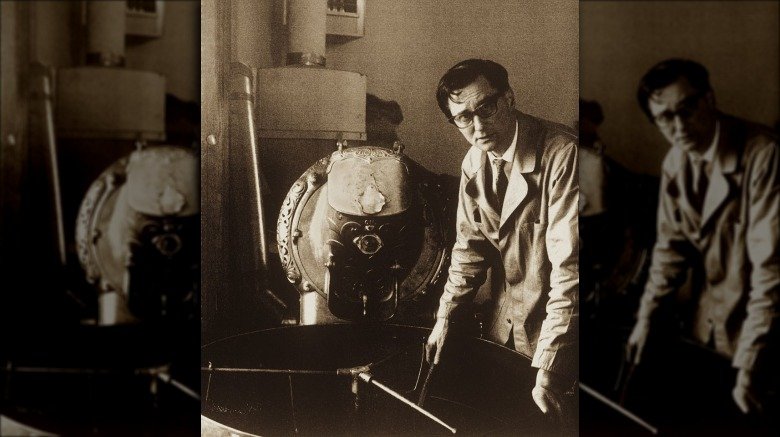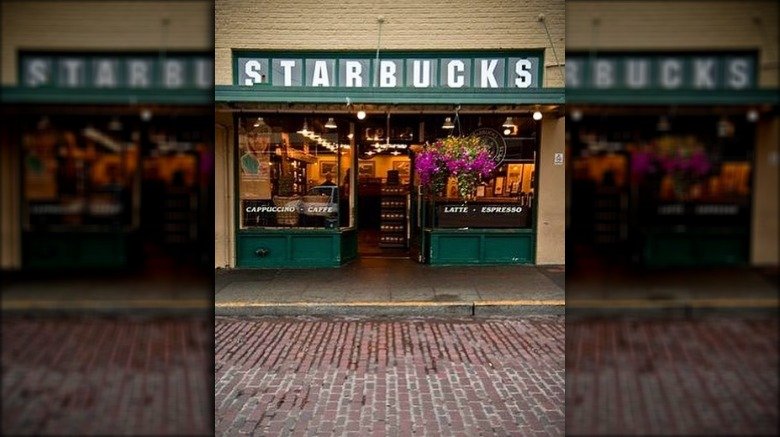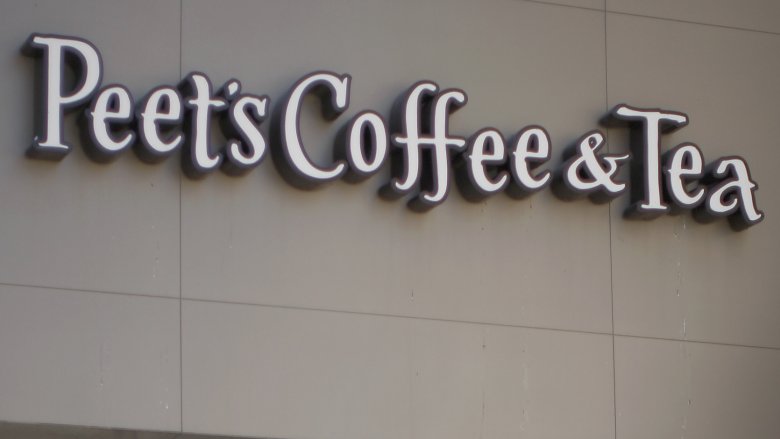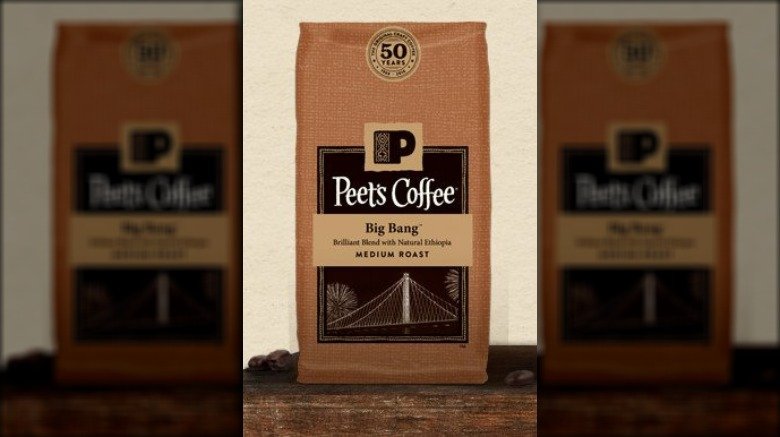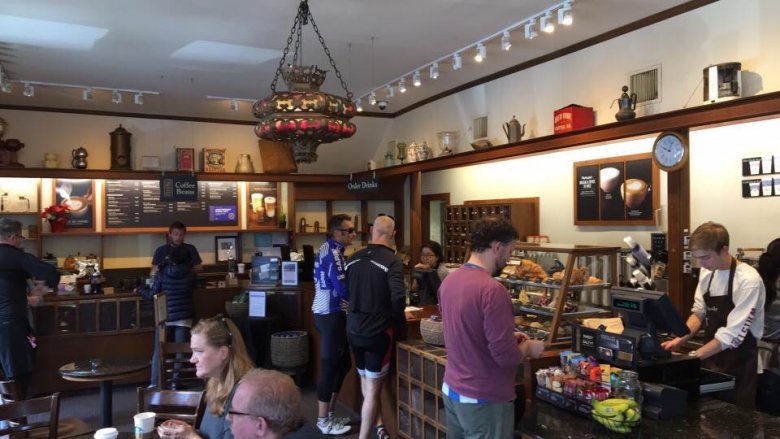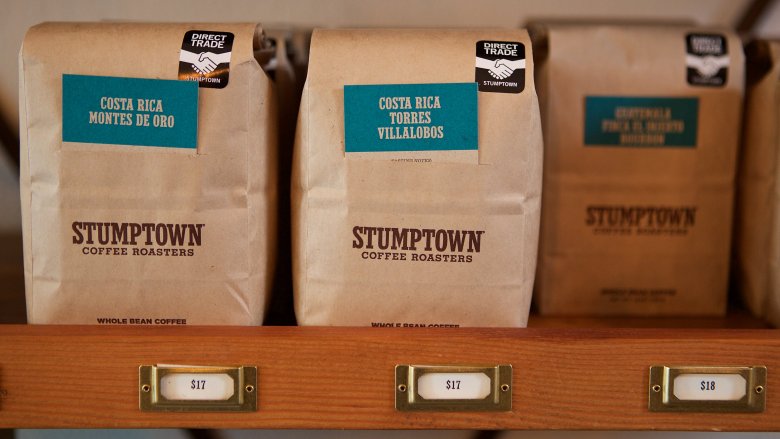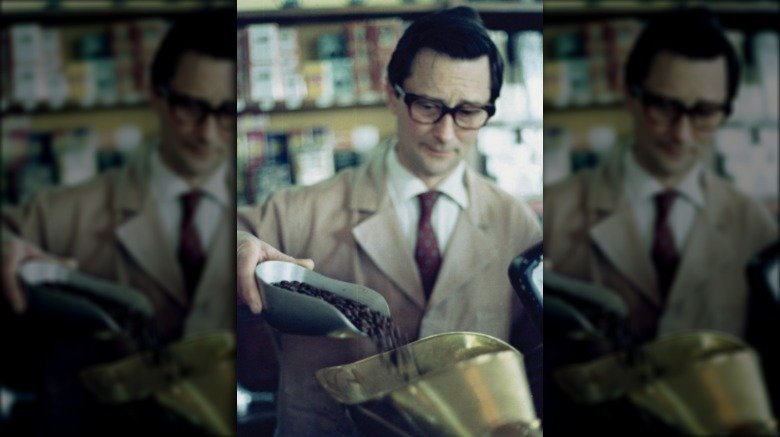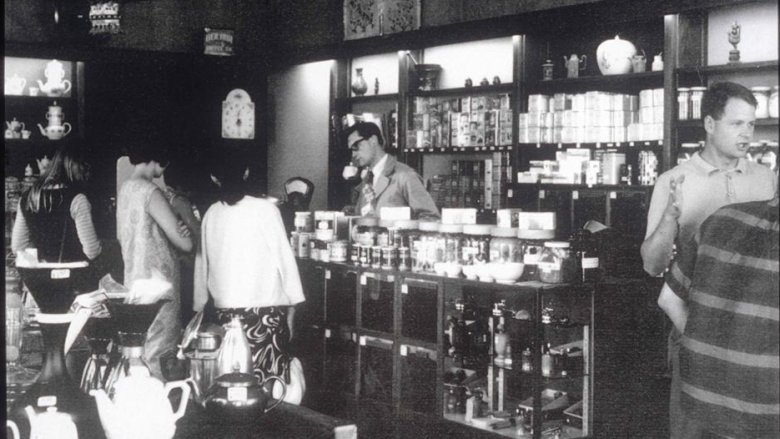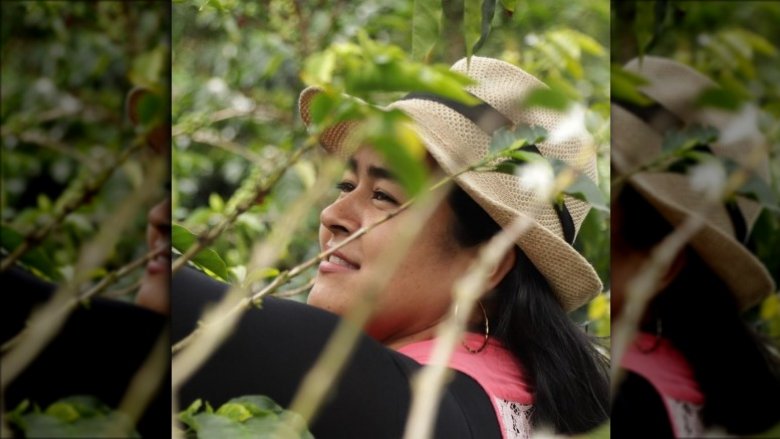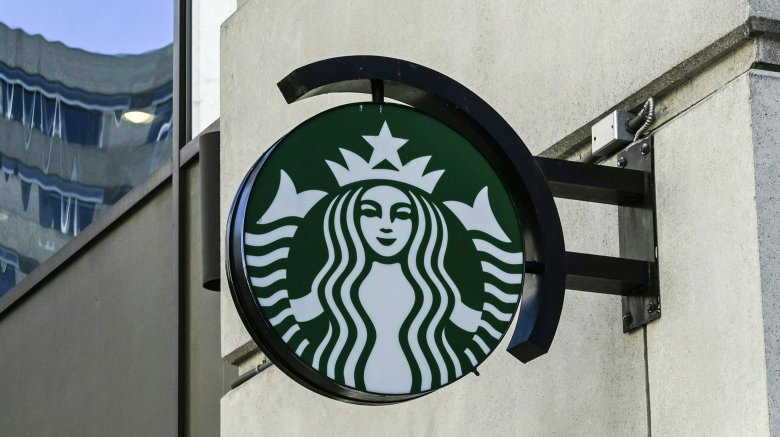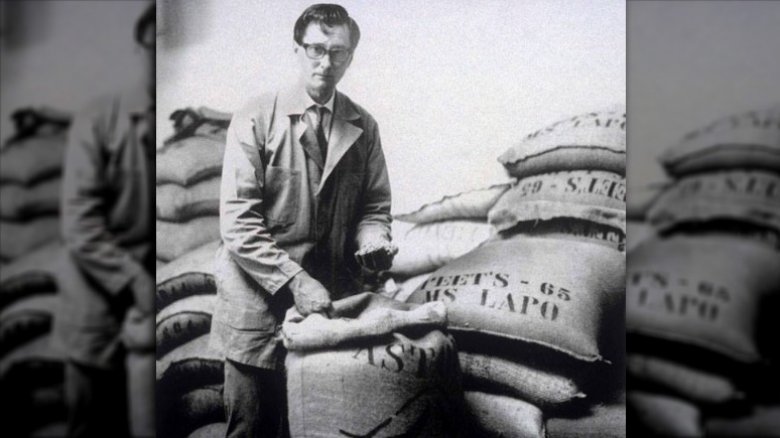The Untold Truth Of Peet's Coffee
When most people think about coffee chains in the United States, they probably think of Starbucks, which is the largest coffee chain in the U.S. and, in fact, the entire world.
But before Starbucks, before Dunkin' Donuts, before K-Cups, there was one coffee joint that started the American specialty coffee industry as we know it today: Peet's Coffee.
Started in California in 1966, Peet's served up a new kind of coffee to the American customer — fresh, dark-roasted coffee beans. It's the style now preferred at Starbucks and independent cafes alike, but it all started with Alfred Peet, a Dutch immigrant in the U.S. with a love for java and a dream.
Peet's Coffee remains a small but successful chain to this day, with about 240 locations in the United States, but its legacy looms large in the coffee world. Not only did the Peet's founder have a huge impact on the founders of Starbucks, but on pretty much all of the specialty coffee we drink today. So how did one man's dream of owning a coffee company in America change the way we appreciate and understand coffee? There's more to the story than you might expect.
The founder of Peet's thought American coffee sucked
These days, it seems like there's a coffee shop on every corner — there were more than 31,490 as of 2015. So what on earth would inspire someone to go all in on a brand new coffee chain?
Well, simply put, when Alfred Peet first came to America in 1955, the coffee being served in most restaurants and cafes... kind of sucked. Peet grew up in the coffee trade and was used to European coffee culture, so when he first tasted the poor quality coffee in America, he was shocked. "I came to the richest country in the world, so why are they drinking the lousiest coffee?" Peet is quoted as saying. He was appalled that Americans would brag about drinking 10 cups of coffee in a day, because Peet knew that only watery, low-quality coffee could be consumed in such volumes.
Peet theorized that American coffee tasted so bad because during WWII, coffee was rationed. WWII also saw the advent of the instant coffee industry, so people just weren't drinking coffee made from fresh beans anymore.
Determined to change things, Peet started importing his own coffee beans and roasting them by hand the way he had learned in Jaca, Indonesia. His robust, dark-roasted beans were a lot different than the watery stuff being served in restaurants and cafes, and it was only a matter of time before his business took off.
The Peet's founder inspired the owners of Starbucks to open their first store
In 1966, when Alfred Peet opened the first Peet's Coffee, he only sold coffee beans. But his beans were dark roasted and tasted different than most of the coffee that was available on the market at the time. Three friends — the future founders of Starbucks — took note. They decided to open their own coffee shop up in Seattle, but first they needed to learn the ins and outs of the business.
They worked for Peet over Christmas in 1970, and Peet taught them all about coffee, including how to source and roast coffee beans. They became very close, not just as business associates but personally — it's said that Peet saw the three men, Zev Siegel, Gordon Bowker, and Jerry Baldwin, as his sons.
When the first Starbucks opened in 1971, Peet gave them full permission to copy the design of his store, according to the three men. Starbucks also started off selling Peet's roasted beans, until they acquired their first roaster. Like Peet's when it first started out, the first Starbucks only sold freshly roasted coffee beans when it began, and didn't venture into the world of brewing coffee for sale until some years later. Also like Peet's, Starbucks' first foray into brewing coffee was setting up a coffee bar so that customers could sample the beans before taking them home, a concept that obviously proved successful.
Peet's basically invented the American specialty coffee industry
Alfred Peet has been called the man who "started the craft coffee revolution," "the man who taught the world to drink coffee," and "the Dutchman who taught Americans how to drink coffee." Most coffee experts and historians agree that it was Peet, thanks to his experience in Europe and his experience working in the coffee and tea industry in Java, Indonesia, who really kickstarted the American coffee revolution.
Peet opened the first Peet's Coffee on April 1, 1966, with a 25-pound roaster, 10 pounds of Columbian coffee beans, and the money left to him by his father as his startup capital. At first, not everyone loved his coffee — it was just so much stronger than what people were used to. Peet sold fresh roasted beans out of his store, but also had a coffee bar, where potential customers could taste his brews before deciding to buy a bag of beans. European customers were immediately smitten, and soon word spread.
Peet trained his employees in how to "cup" coffee, which is similar to how experts evaluate wine — coffee is smelled, tasted, and judged based on a variety of factors. Peet said that the coffee beans had a language, and he's credited with being the one who taught people how to listen to that language, ushering in a new era of American coffee, where every sip and sniff was something to take seriously.
Peet's was once sold for almost $1 billion
Unlike Peet's Coffee protege Starbucks, which has close to 14,300 stores in the United States alone, Peet's has kept things relatively small, with only around 240 stores in the U.S., scattered among a handful of states.
But the number of stores isn't the only metric for company value, especially in this case. Peet's started out selling coffee beans, and these days their bags of roasted coffee beans are still sold in more than 14,000 grocery stores nationwide. This might be why, in 2012, they were sold to German company Joh. A. Benckiser for almost $1 billion — $977.6 million, to be exact.
Peet's retained its management team and employees after the sale. The conglomerate that bought the coffee company was at the time best known for owning beauty brands like Coty and luxury goods company Labelux, which might be why some people who thought initially that Starbucks would go after Peet's when it went public, were surprised by the sale. They must have had coffee on their mind, however, because in 2012 JAB also bought Caribou Coffee, a chain of cafes that has nearly 500 locations globally. These days JAB owns more than a few other famous food brands, including Panera Bread, Krispy Kreme, and Dr Pepper.
The original Peet's Coffee location is still in business
The original Starbucks location is an international tourist destination to this day, with lines hundreds of feet long queuing up outside the shop in Seattle's Pike Place Market. Some guests stand outside the store for hours waiting to order a drink. But real coffee fans would do better to venture south to Berkeley, California, where the original Peet's Coffee is still in operation today. After all, the original Peet's is what inspired the original Starbucks to begin with, and it apparently has held on to the laid back, hippie vibe that made it so famous.
While the original Starbucks is more of a busy tourist destination than a functional coffee shop, the original Peet's Coffee is considered to be a staple for coffee lovers in the neighborhood to this very day. The shop is just steps away from the UC Berkeley campus and close to downtown Berkeley, and it's had a steady stream of students, professors, and locals walking through its doors for decades now.
Those who do want a little history with their java will be pleased to know that there's a museum in back of the original Peet's, featuring old photographs, newspaper clippings, and vintage coffee making equipment. Though lines get long in the mornings, apparently the cafe calms down midday, so you can sip your coffee while contemplating the chain's place in history.
Peet's owns Stumptown and Intelligentsia
A lot of people think of Peet's as the little coffee shop that could, a small chain of less than 300 stores that made a name based on the quality of its coffee alone. But like any other business venture, Peet's has its eyes set on expansion, or at least it would seem so when you start to dive into their business history.
Peet's began as a small indie coffee company, but they started acquiring brands in the 2010s. First, they bought Mighty Leaf tea in 2014, a company sales in the double-digit millions that specializes in blended teas with unique flavors. Now, its the signature tea brand brewed and served at Peet's Coffee cafes.
In 2015, they decided to dip their toes into darker roasted waters — namely, they acquired two new coffee companies. Intelligentsia, from Chicago, specializes in high-end coffee, while Oregon's Stumptown is know for being a pioneer in serving and bottling and selling cold brew.
Even though Peet's started out with tons of credibility in the coffee industry, by the time it bought these two coffee companies, some customers were concerned. Some fans wondered whether the acquisition would ruin the quality of their fave indie roasters, but others were enthusiastic, hoping that joining with Peet's and gaining access to their resources would help bring their favorite coffee to the rest of the world.
The founder of Peet's was forced to work in a German labor camp during WWII
At first, it might sound like the founder of Peet's Coffee lived a charm life. Born in the Netherlands to a family that owned a coffee, tea, and spice company and an uncle that ran a coffee company, it seemed like his path was set, but he encountered a few bumps on the way.
The first, minor bump, was that his family didn't want him to pursue a career in coffee. They wanted him to become educated at university, and to pursue a more academic life. But Peet already had experience in his father's business, and had already caught the coffee bug.
Then, something happened that threw this mild family drama into stark relief — Peet was imprisoned against his will in a German labor camp during WWII. Though he refused to register with German troops he was captured on the street and forced to toil in a factory, where, strangely enough, the hard work ethic he was known for in later years annoyed his fellow prisoners, who feared he was "working for the enemy."
Peet eventually escaped the labor camp, moving to Indonesia in 1948 and learning about coffee in Java and Sumatra, then heading to New Zealand in 1950 and living there for a time before eventually flying to and settling down in Berkeley, California, in 1955.
The original Peet's was a beloved hippie hangout
The first Peet's Coffee shop was opened at the intersection of Vine and Walnut streets just blocks from the UC Berkeley campus, in the 1960s. At the time, Berkeley was one of the epicenters of the anti-Vietnam war movement, attracting artists like Joan Baez and politicians like Dr. Martin Luther King Jr, to campus to speak to the passionate student body.
That also means that much of Peet's original client base was made up of hippies. Known as "Peetniks," a nickname the brand now uses for its customer rewards programs, these coffee fans weren't exactly beloved by Alfred Peet himself. "I wanted an orderly business," he said, "and some of those guys were smelly."
One customer recalls going to Peet's for the first time and finding the storefront surrounded by a "somewhat motley crew of aging hippies," who were reading poetry, playing the mandolin, and passionately discussing politics.
This little hippie corner of Berkeley, anchored by Peet's Coffee, became known as "the Gourmet Ghetto," and shared a neighborhood with other now-famous institutions like Chez Panisse. In fact, Peet was the one who introduced chef Alice Waters to high quality coffee, which she says showed her "a new way to look at food, wine and coffee."
Peet's has a farmer's assistance program that helps coffee growers worldwide
Commercial coffee farming comes with a lot of challenges. Sourcing environmentally-friendly, ethically grown coffee where workers are being appropriately compensated for their labor isn't something that a lot of companies get right, but Peet's is certainly trying their best.
Peet's participates in direct trade with coffee growers rather than going through a third party, which means they have more transparency when it comes to supply chain management and worker conditions, and they also prioritize coffees that have received USDA Organic, Fair Trade, and Rainforest Alliance certifications.
But instead of ignoring smaller family farms in favor of larger operations who are already up to snuff, they've created a Farmer Assistance Program. The program basically looks for smallholder farmers who could be producing high-quality beans that are up to Peet's standards, with just a little help.
The program teaches farmers modern techniques that help produce better coffee while reducing environmental impact. In some areas, their partner TechnoSource trains employees in new techniques, and in others, like Guatemala, coffee growers are given assistance in finding the resources to teach each other and share their expertise in areas like shade tree management, harvesting, pruning, and more. The hope is that the assistance program can help transform the coffee industry into one that's more sustainable on both a human and environmental level.
At one time, Starbucks owned Peet's
When Alfred Peet died at the age of 87 in 2007, he was eulogized by many heavy-hitters in the coffee industry, but perhaps no one had as intimate a relationship with Peet than Jerry Baldwin, one of the co-founders of Starbucks.
Baldwin learned everything about the coffee industry from Peet. "Peet supplied us with roasted coffee, and he taught me how to roast coffee... He was very generous," Baldwin said. But the histories of both Starbucks and Peet's are even more closely entwined than you might think. That's because at one point Starbucks actually bought Peet's Coffee.
It's a little confusing, but bear with us. Baldwin opened Starbucks with friends Gordon Bowker and Zev Siegel and was president of the company until 1987, but in 1984, when Baldwin learned that Peet's Coffee was up for sale, he bought it. After three years, Baldwin seemed to realize that Peet's was where his true passion lied. He eventually sold his shares of Starbucks to now-CEO Howard Schultz, giving up his ownership stake in the company, so that he could focus on Peet's. To this day, Baldwin is still on the board of directors at Peet's Coffee.
Alfred Peet never married
Alfred Peet may have been beloved by those he mentored, and his customers adored him, but the man wasn't exactly known for his relaxed or cheerful demeanor.
Though he was an internationally successful business man with legions of fans in the coffee industry, according to some, he was stressed out and grumpy (especially around his hippie clientele). Perhaps that's why, in spite of his success, Peet never married.
One of his nicknames is the "coffee curmudgeon supreme," and it seems like he may have earned it. He was known for being serious and professional, and if his workers didn't listen to him, he let them know he wasn't impressed.
Peet himself said that "The only thing that has always been weak is my interpersonal relations," and that it was this shortcoming that lead to the sale of the company. He was also stressed. "I worked too hard, because I couldn't delegate... I was burnt out, so I had to sell... At the time, it broke my heart."
He sold his company in 1979 for $1 to 2 million. He had just turned 60, and it's said that he struggled with depression after the sale.
Peet never married, living a quiet life in Berkeley until his death at age 87. Though some say he was bitter, he allegedly had a group of close friends until his death, so even though he didn't have any public romantic relationships, we can hope that he was happy.
